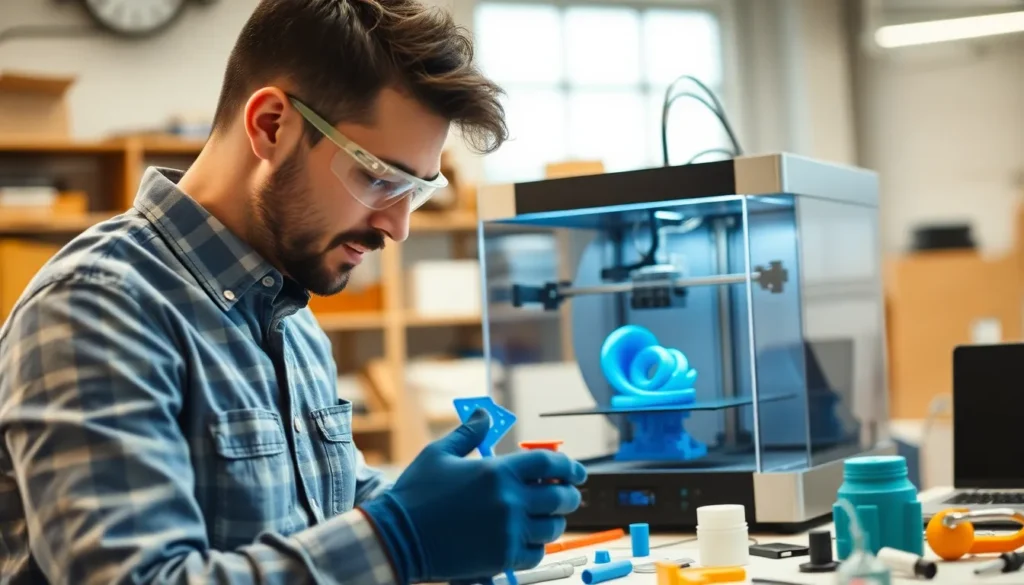Table of Contents
ToggleWhen it comes to 3D printing, the build plate is the unsung hero of the show. It’s the sturdy stage where all the magic happens, yet it often gets less attention than that flashy printer itself. But let’s face it—without a solid build plate, that intricate design is just a pile of melted plastic waiting to happen.
Overview of 3D Printer Build Plates
3D printer build plates, often overlooked, significantly influence printing quality. Various materials, including glass, aluminum, and plastic, serve as build plate options, each offering unique advantages. Glass provides a smooth surface, promoting adhesion and producing excellent first layers. In contrast, aluminum offers durability and heat conductivity, ensuring even temperature distribution.
Surface texture can affect adhesion. A textured build plate surface enhances grip, preventing prints from warping or shifting during the process. Some users prefer powder-coated surfaces for a balance between stickiness and ease of removal. Others opt for removable build surfaces that simplify the print removal process.
Size matters when choosing a build plate. An appropriate size accommodates specific print dimensions, preventing material waste. Small build plates cater to compact designs, while larger ones support ambitious projects. Knowing the correct dimensions can greatly impact printing efficiency.
Maintenance plays a vital role in maintaining optimal print quality. Regular cleaning prevents residue buildup, allowing for consistent adhesion. Users should consider inspecting the build plate for warping or scratches, which can affect future prints.
Experimentation is key when finding the right build plate for each project. Different materials and textures yield various results, and adjusting adhesion methods can improve print quality. For instance, using adhesives or specialty sprays can enhance grip on the build plate, ensuring successful prints.
Understanding 3D printer build plates fosters better printing outcomes. Making informed choices about materials, surfaces, and maintenance can lead to high-quality prints, unlocking the full potential of 3D printing technology.
Types of 3D Printer Build Plates
Different types of 3D printer build plates cater to varying printing needs and preferences. Each option has distinct advantages that can enhance the quality of prints.
Glass Build Plates
Glass build plates promote excellent adhesion, particularly for materials like PLA and PETG. The smooth surface often results in a fine first layer, leading to more precise prints. Many users appreciate the ease of cleaning; glass surfaces resist sticking, making maintenance straightforward. Availability in various sizes ensures compatibility with most printers. Users often find that glass plates remain flat over time, reducing warping issues.
Aluminum Build Plates
Aluminum build plates offer durability and lightweight properties, making them a popular choice among enthusiasts. This material distributes heat evenly across the surface, promoting consistent printing temperatures. Some manufacturers treat aluminum surfaces with a powder coating, providing additional grip for various filaments. Users also benefit from its resistance to bending and warping under pressure, which enhances overall print reliability. Most aluminum plates allow for easy detachment of printed objects, streamlining the post-print process.
PEI Coated Build Plates
PEI coated build plates are known for their excellent adhesion capabilities and ease of use. Users frequently report that prints adhere well during the process yet detach easily once cooled. Some favor this type for printing with a wide range of materials, including flexible filaments. The texture of the PEI surface contributes to reducing warping and shifting during printing, leading to higher quality outcomes. Maintenance remains uncomplicated, as these surfaces typically require just a simple wipe-down to keep clean.
Magnetic Build Plates
Magnetic build plates simplify the print removal process considerably. Users appreciate the convenience of flexible magnetic surfaces that allow for quick bend-and-peel detachment of prints. These build plates often come with an adhesive backing for easy attachment to the printer’s bed. Some magnetic plates include a textured surface, enhancing grip and print stability. Flexibility in design means these plates work well with a variety of filament types, catering to diverse user needs.
Factors to Consider When Choosing a Build Plate
Selecting the right build plate enhances printing precision and quality. Several key factors govern this choice.
Print Material Compatibility
Compatibility with various print materials is essential for successful printing. Build plates like PEI-coated options work exceptionally well with filaments such as PLA and ABS. Glass plates provide strong adhesion for materials with lower temperature requirements. Some materials, including TPU, require a different surface texture for optimal adhesion. Understanding these interactions ensures prints adhere correctly, minimizing issues like warping.
Temperature Resistance
Temperature resistance plays a significant role in determining the effectiveness of a build plate. Materials like aluminum withstand higher temperatures and maintain consistent heat distribution. On the other hand, glass plates may crack if subjected to rapid thermal changes. PEI-coated build plates effectively handle a broad temperature range without losing performance. Prioritizing temperature resistance prevents damage to the plate and ensures stable printing environments.
Adhesion Properties
Adhesion properties significantly impact print success. Strong adhesion minimizes the risk of prints shifting during the process, enhancing overall quality. Glass and PEI-coated plates often deliver excellent adhesion for various filament types. Magnetic build plates provide flexibility, simplifying print removal while offering sufficient grip during printing. Evaluating adhesion properties helps in choosing a build plate that matches specific project needs, ensuring smoother print outcomes.
Maintenance Tips for 3D Printer Build Plates
Maintaining a 3D printer build plate enhances print quality. Regular attention prevents common issues.
Cleaning Methods
Effective cleaning methods ensure optimal adhesion and longevity of build plates. Isopropyl alcohol works well for removing residue from glass or aluminum surfaces. Using a soft cloth ensures no scratches occur during cleaning. For tougher build-up, a gentle plastic scraper can remove excess materials without damaging the plate. Regular inspections help identify any signs of wear or damage. Clear any debris after each print to maintain an uncluttered workspace. This routine can significantly improve the success of future prints.
Damage Prevention
Preventing damage to build plates ensures consistent print quality. Placing a protective layer, such as painter’s tape, minimizes scratching during filament removal. Adjusting print bed temperature according to the material used reduces warping. Regular calibration of the printer helps maintain the correct distance between the nozzle and the plate. Utilizing a flexible or magnetic build plate allows for easier removal, thereby limiting potential cracks or scratches. Storing build plates in a dust-free environment helps prevent contamination and wear over time.
Conclusion
Understanding the role of build plates is vital for anyone looking to enhance their 3D printing experience. The right build plate can significantly impact print quality and efficiency. By selecting materials that suit specific printing needs and maintaining these surfaces properly, users can achieve impressive results.
Experimenting with different types of build plates can lead to discovering the perfect fit for various projects. Whether opting for glass, aluminum, or magnetic options, each type offers unique benefits that cater to individual preferences. Prioritizing maintenance and compatibility ensures longevity and optimal performance, ultimately unlocking the full potential of 3D printing technology.




